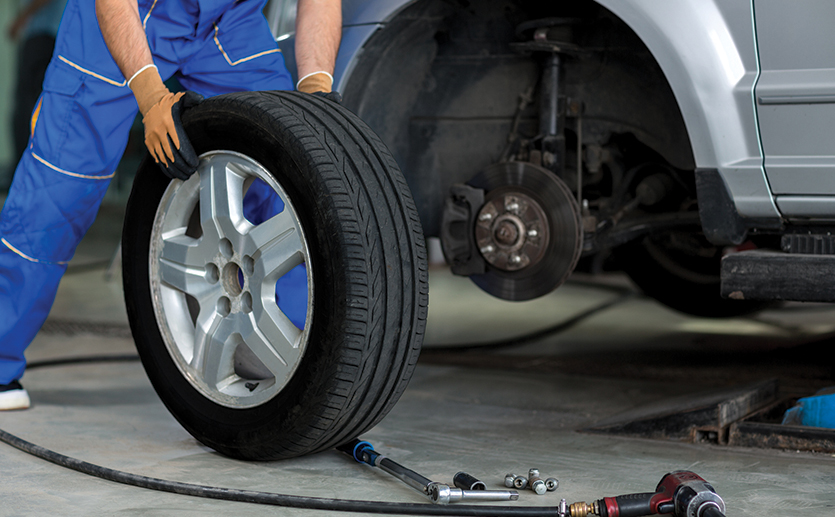Drive with Self-confidence: GMC Tires Service at Morris Tires
Drive with Self-confidence: GMC Tires Service at Morris Tires
Blog Article
Tire Service: The Effect of Weather Conditions
When it comes to guaranteeing optimum performance and safety and security on the road, understanding the effect of weather condition problems on tire service is critical. GMC Tire Service. In this discussion, we will check out the intricate connection between weather condition conditions and tire service, shedding light on the relevance of weather-specific tire upkeep techniques and considerations.
Warm and Tire Efficiency
When revealed to high temperatures, tires experience modifications in performance that can considerably affect lorry safety and security and handling. The warm produced from extended driving or hot weather problems triggers the tire rubber to soften, leading to minimized step life and boosted wear.

Cold Climate Impacts
Winter conditions can have a substantial influence on tire efficiency and safety and security. As temperature levels drop, tire rubber can set, resulting in decreased grip on icy or snow-covered roads. In winter, tires might additionally shed air pressure a lot more swiftly, which can influence managing and fuel performance. Furthermore, cold temperatures can trigger tire sidewalls to tense, increasing the threat of damages from pits or various other roadway dangers.
To mitigate the effects of winter on tires, it is important to routinely check tire pressure and inflate them to the supplier's advised levels. Making use of winter or all-season tires created for winter problems can likewise improve traction and hold on icy or snowy roadways. Proper tire upkeep, including regular evaluations for wear and damages, comes to be even a lot more critical throughout chillier months to guarantee ideal efficiency and security.
Rainy Issues Impact
Throughout wet conditions, tire efficiency and safety and security can be substantially affected by the damp road surfaces and decreased presence. The walk pattern of tires plays an essential role in preserving grip on damp roadways. Tires with worn-out treads are extra vulnerable to hydroplaning, where a layer of water constructs up between the tire and the road surface, bring about loss of grip. To fight this, vehicle drivers should frequently inspect their tires for ample tread depth and consider buying tires especially check out this site designed for damp conditions.
Furthermore, rainy weather can additionally lower exposure, making it challenging for drivers to see the road in advance clearly (GMC Tire Service). In such conditions, it is necessary to readjust driving speeds appropriately and keep a risk-free adhering to distance to enable abrupt stops. Appropriately inflated tires can additionally help in keeping control on damp roads by supplying far better handling and grip
Snow and Tire Safety And Security
Snow-covered roadways position special challenges for chauffeurs, stressing the value of correct tire choice and upkeep. When driving in snowy conditions, having the right tires Recommended Site can make a substantial difference in safety and security and performance. Winter months tires are developed with unique rubber substances and step patterns to give better grip on snow and ice contrasted to all-season tires. The much deeper footsteps and sipes of winter tires aid grip the road much better, reducing the threat of slipping and moving.

Additionally, motorists should think about setting up tire chains in severe snowy problems. Tire chains offer added grip by clutching the snow and ice, boosting security and control. It is essential to comply with maker directions when mounting and making use of tire chains to prevent damages to the tires and car (GMC Tire Service). By picking the appropriate tires, keeping appropriate inflation, and taking into consideration additional grip help like tire chains, motorists see can boost their security when browsing snow-covered roadways.
Weather-Related Tire Upkeep
Weather-related tire upkeep encompasses an array of techniques intended at guaranteeing optimum tire function and durability in various weather condition scenarios. One crucial aspect of weather-related tire upkeep is tire pressure guideline. Inspecting tire step regularly and changing tires when walk wear reaches a particular deepness is essential for keeping traction and stability in unfavorable weather.
Verdict
In verdict, weather condition conditions have a substantial effect on tire performance and safety. From warmth affecting tire pressure and put on to cool climate decreasing grip, it is vital to take into consideration the weather when keeping and utilizing tires.
In this conversation, we will certainly explore the elaborate partnership in between weather conditions and tire solution, dropping light on the importance of weather-specific tire maintenance techniques and considerations.

Report this page